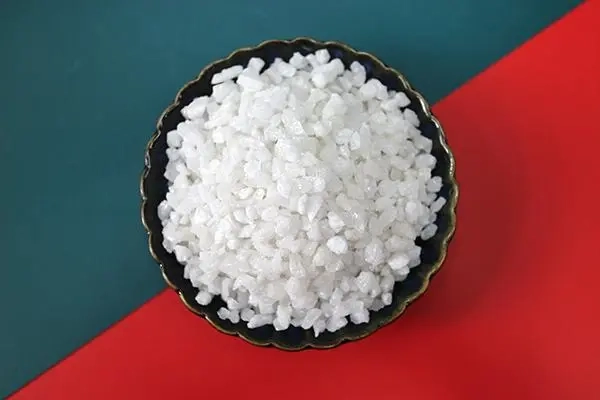White corundum is made from industrial alumina powder as raw material. It is melted in an electric arc at a high temperature of more than 2000 degrees and then cooled. It is crushed and shaped, magnetically separated to remove iron, and screened into various particle sizes. Its texture is dense and hard, and the particles form sharp corners. shape, suitable for manufacturing ceramics, resin-bonded abrasives, grinding, polishing, sandblasting, precision casting (special corundum for precision casting), etc., and can also be used to manufacture advanced refractory materials.
However, we found that the color of white corundum can appear red, red-yellow, or blue-gray, which affects the appearance of the product. And there is sodium oxide in the content. A small amount of sodium oxide will consume a large amount of Al2O3 (18.10 times the mass of Na2O) to form sodium aluminate. Therefore, in addition to stipulating the Al2O3 content, the chemical composition standards of white corundum also strictly limit the Na2O content. Since there are few other components in the alumina powder except Al2O3 and a trace amount of Na2O.
Through theoretical analysis and a large number of experiments, we draw the main conclusions:
- 1.The color change of white corundum abrasive tools is mainly determined by the impurity content in the binder and the firing atmosphere. If fired in an oxidative atmosphere, when the (TiO2+Fe2O3) content in the binder is <0.55%, white corundum will not show red or reddish-yellow tones. As the content of Fe2O3 and TiO2 in the binder increases, the white corundum abrasive tools appear red and the red-yellow tone gradually increases. Therefore, if the (TiO2+Fe2O3) content in the binder is >0.55%, it is not appropriate to fire the white corundum abrasive tools. Use an oxidizing atmosphere, preferably a neutral atmosphere or a weak oxidizing atmosphere for firing.
- Adding talc powder, quartz powder, and magnesium oxide powder to the ceramic bond white corundum grinding tool binder can eliminate the red color of white corundum, but it will affect the strength of the grinding tool.
White corundum abrasive is a kind of artificial abrasive. Its production method is very complicated. It is made using a special smelting process. The white corundum is then crushed and shaped, magnetically separated to remove iron and other processes, and then screened into a variety of particle sizes. The white corundum particle size How to detect it? Here is a detailed summary and introduction to several methods:
- 1.Sieving method. Advantages: simple, intuitive, low equipment cost, often used for samples larger than 40um. Disadvantages: The results are greatly affected by human factors and mesh deformation.
- 2.Microscopy (image) method. Advantages: simple, intuitive, capable of morphological analysis, suitable for samples with narrow distribution (the ratio of the maximum and minimum particle sizes is less than 10:1). Disadvantages: Poor representativeness, it is troublesome to analyze samples with a wide distribution range, and samples smaller than 1um cannot be analyzed.
- 3.Sedimentation method (including gravity sedimentation and Lixin sedimentation). Advantages: gradual operation, the instrument can run continuously, low price, good accuracy and repeatability, and wide test range. Disadvantages: The test takes a long time and the operation is cumbersome.
- 4.resistance method. Advantages: Gradient operation can measure the number of particles, the equivalent concept is clear, fast, and accurate. Disadvantages: Not suitable for measuring particle samples smaller than 0.1um. It is troublesome to replace small-hole tubes for samples with wide particle size distribution.
- 5.Laser method. Advantages: easy operation, fast testing speed, wide testing range, good repeatability and accuracy, and can perform online measurement and dry measurement. Disadvantages: The results are greatly affected by the distribution model, the instrument cost is high, and the resolution is low.
- 6.Electron microscopy. Advantages: Suitable for testing ultra-new particles or even nanoparticles, high resolution, and capable of morphological and structural analysis. Disadvantages: few samples, poor representativeness, measurement is easily affected by human factors, and the instrument is expensive.
- 7.Photoresist method. Advantages: The test is convenient and fast, can measure the number of particles in liquid or gas, and has high resolution. Disadvantages: It is not suitable for samples with a particle size less than 1umde. The system is rather finicky. It is only suitable for measuring dust, pollutants or diluted drugs. It is not used much for general powders.
- 8.Breathing method. Advantages: The instrument is low in price. There is no need to disperse the sample, and the testable material powder can be measured. Disadvantages: Only the average particle size value can be obtained, and the particle size distribution cannot be measured; fine powder smaller than 5um cannot be measured.
- 9.X-ray small angle scattering method. For particle size measurement of nanoscale particles.
- 10.Photon correlation spectroscopy (dynamic light scattering). For particle size measurement of nanoscale particles.
